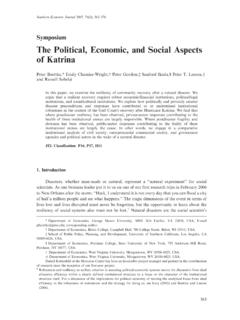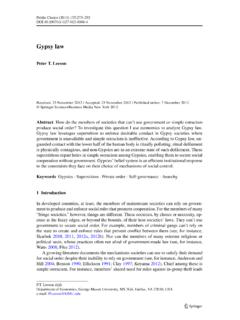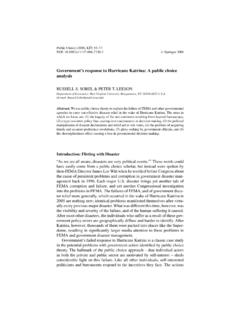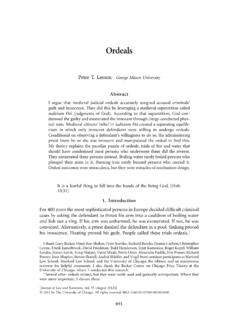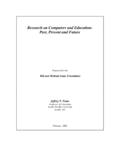Transcription of An-arrgh-chy: The Law and Economics of Pirate …
1 1049[Journal of Political Economy,2007, vol. 115, no. 6] 2007 by The University of Chicago. All rights reserved. 0022-3808/2007/11506-0001$ : the law and Economics of PirateOrganizationPeter T. LeesonGeorge Mason UniversityThis article investigates the internal governance institutions of violentcriminal enterprise by examining the law, Economics , and organiza-tion of pirates. To effectively organize their banditry, pirates requiredmechanisms to prevent internal predation, minimize crew conflict,and maximize piratical profit. Pirates devised two institutions for thispurpose. First, I analyze the system of piratical checks and balancescrews used to constrain captain predation. Second, I examine howpirates used democratic constitutions to minimize conflict and createpiratical law and order. Pirate governance created sufficient order andcooperation to make pirates one of the most sophisticated and suc-cessful criminal organizations in , we see, teaches the most Illiterate the necessaryPrudence for their Preservation.
2 These Men whom weterm, and not without Reason, the Scandal of human Na-ture, who were abandoned to all Vice, and lived by Rapine;when they judged it for their Interest .. were strictly just.. among themselves. (Captain Charles Johnson 1726 28, 527)I am especially grateful to Steven Levitt and two anonymous referees for thorough andinsightful comments on an earlier draft of this paper. I also thank Pete Boettke, TylerCowen, Chris Coyne, Josh Hill, Bill Reece, Andrei Shleifer, Russell S. Sobel, Werner Troes-ken, and William Trumbull for helpful comments and suggestions. The financial supportof the Kendrick Fund and the Kaplan Fund is also gratefully of political are known for raucousness, recklessness, and chaotic reality, however, is quite another picture. Real-life pirates werehighly organized criminals. Unlike the swashbuckling psychopaths offiction, historical pirates displayed sophisticated organization could not use government to enforce or otherwise supportcooperative arrangements between them.
3 Despite this, they successfullycooperated with hundreds of other rogues. Amidst ubiquitous potentialfor conflict, they rarely fought, stole from, or deceived one another. Infact, piratical harmony was as common as harmony among their lawfulcontemporaries who relied on government for social cooperation. Howdid these men whom we term .. the Scandal of human Nature, whowere abandoned to all Vice, and lived by Rapine ( Johnson [1726 28]1999, 527)1accomplish this impressive level of order?Becker (1968) was the first to apply the logic of rational-choice de-cision making to criminals. Following him, a number of others extendedthis logic to decision making in the context of organized outlaws. Fior-entini and Peltzman (1995) provide the best and most comprehensivecollection of essays that consider the Economics of criminal organiza-tion. In addition, a large literature discusses the economic impact oforganized crime, activities of criminal organizations, optimal strategiesfor preventing organized crime, and reasons for its emergence (see also, , Anderson 1979; Reuter 1983, 1987; Jennings 1984; Arlacchi 1986;Jankowski 1991; Dick 1995; Konrad and Skaperdas 1998; Garoupa 2000;Skaperdas 2001; Chang, Lu, and Chen 2005).
4 Unlike these topics, the internal governance institutions of violentcriminal organizations have received relatively little dif-ficulty of getting inside criminal organizations is largely responsiblefor this. Levitt and Venkatesh s important work on street gangs (Levittand Venkatesh 2000; Venkatesh and Levitt 2000) is an exception to thisrule, as are Gambetta s (1993) and Reuter s (1983) superb studies ofthe Mafia. However, Levitt and Venkatesh focus on the financial orga-nization of gangs rather than on their governance structures. Gambetta sand Reuter s studies are primarily concerned with the Mafia s provisionof protection to outsiders and the organization of the illegal markets page references to Johnson refer to the 1999 reprint. Page references to otherearly sources also refer to reprint editions if (1979), Reuter (1983), and Gambetta (1993) are the closest exceptions inthis regard. Their excellent work considers some internal governance aspects of the Mafiabut tends to focus primarily on the Mafia s relationship to protection and other research by Polo (1995) examines governance institutions of criminal orga-nizations, but does so and Economics of Pirate organization1051 This article investigates the internal governance institutions of violentcriminal enterprise by examining the law, Economics , and organizationof most treacherous rogues terrorized the Caribbean,Atlantic Ocean, and Indian Ocean during the seventeenth and eigh-teenth centuries.
5 Pirates formed a loose confederation of maritime ban-dits outside the law of any effectively organize their banditry, pirates required mechanismsto prevent internal predation, minimize crew conflict, and maximizepiratical profit. I argue that pirates devised two institutions for this pur-pose. First, I analyze the system of piratical checks and balances thatcrews used to constrain captain predation. Second, I examine how pi-rates used democratic constitutions to minimize conflict and create pi-ratical law and order. Pirates adopted both of these institutions beforeseventeenth- and eighteenth-century governance institutions were self-enforcing by necessity. Ap-pealing to the formal enforcement mechanisms of the state is not anoption for criminal organizations, including pirates. Although the mar-itime nature of piratical expeditions makes certain aspects of theirinternal organization and governance specific to pirates, my analysishighlights important problems that any form of organized criminal en-terprise faces, as well as the institutional solutions such organizationsemploy to overcome these literature that addresses the Economics of organized crime fo-cuses on the criminal organization as a supplier of some service, usuallyprotection, to other actors inside and outside the criminal world.
6 Schel-ling (1971), for instance, who was among the first to conduct this re-search, identifies the provision of enforcement services to other agentsand, in line with this function, a monopoly on coercion as the distin-guishing features of organized this definition is perhaps appropriate for the Mafia, it neglectsequally important organized criminal activities that do not provide use-ful services to others and do not involve a monopoly on coercion. Anarmy of thieves, for instance, that coordinates its activities, requiresinternal mechanisms of governance, and combines in a long-term ar-rangement for concerted plunder is as much a criminal organizationas the were clearly organized criminals and yet were not primarilyin the business of providing services to anyone other than their did they have a monopoly on force. Because of this, unlike3 This article is also closely connected to the literature that examines the private emer-gence of law and governance institutions.
7 See, , Friedman (1979), Benson (1988, 1989,1990), Anderson and McChesney (2002), Anderson and Hill (2004), Anderson, Benson,and Flanagan (2006), and Leeson (2007a, 2007b, forthcoming).4 However, pirates did trade with European of political economymost discussions of criminal organization, mine takes a broader view oforganized crime. This view encompasses any long-term arrangementbetween multiple criminals that requires coordination and involvesagreements that, owing to their illicit status, cannot be enforced by emphasis of my analysis therefore shifts from the organizationof criminal markets (the focus of existing research on the economicsof organized crime) to the internal predation problem that criminalorganizations face and the institutions that emerge in response to examine these features for pirates, I draw on a series of historicaldocuments that provide a firsthand glimpse into their organization. Thefirst of these is Captain Charles Johnson sGeneral History of the Pyrates(1726 28), which contains reports on a number of history s most in-famous pirates related by a Pirate also draw on Alex-ander Exquemelin s (1678) invaluable account of the seventeenth-century buccaneers.
8 Exquemelin was a surgeon who sailed with thebuccaneers and provides a detailed, firsthand account of their raids,system of rules, and social organization. The buccaneer William Dam-pier (1697 1707) also published a journal relating to his maritime ex-ploits, which I make use of as differ from pure pirates in that they frequently plun-dered ships with government sanction. However, many other times theyplundered without official permission, as full-blown pirates. These pro-topirates, many of whom turned to pure piracy when governmentsstopped issuing licenses for plunder, influenced and anticipated theorganization of pure pirates in the late seventeenth and early eighteenthcenturies. Buccaneer records are therefore important for understandingthe institutions and organization of seventeenth- and addition to these sources, correspondence from colonial governorsrelating to piracy and records from the trials of various pirates, such astestimony from individuals taken prisoner by Pirate ships and the tes-5My definition of a criminal organization is therefore similar to Polo s as one thatcannot rely on the external enforcement of the judicial institutions and whose behaviourand possibilities are not constrained by the law (1995, 87).
9 6 Captain Johnson is a pen name used by the author ofA General History of the true identity remains unknown. In 1932, John R. Moore claimed that Johnson was infact Daniel Defoe. In the late 1980s, however, this view was overturned (see Furbank andOwens 1988), and today many Pirate historians do not believe that Defoe is the authorof this important book (see, , Rediker 2004; Cordingly 2006; Woodard 2007; for theopposing view, see Rogozinski 2000). Whatever Johnson s true identity, it is agreed thathe had extensive first-hand knowledge of piracy (Konstam 2007, 12). While it is widelyacknowledged that Johnson s work contains some errors and apocryphal accounts (suchas the community of Libertalia), Johnson is widely regarded as a highly reliable sourcefor factual information on pirates (Rediker 2004, 180) and remains a definitive sourcehistorians rely on in constructing their accounts of seventeenth- and eighteenth-centurypiracy. As eminent Pirate historian David Cordingly puts it, this book is the prime sourcefor the lives of many pirates of what is often called the Golden Age of Piracy (2006, xx).
10 Law and Economics of Pirate organization1053timony of pirates themselves, form an important part of the historicalrecord this article relies , a few Pirate captives, such as WilliamSnelgrave (1734), whose captors ultimately released them, publishedlonger works describing their harrowing captivity by Pirate alsodraw on these accounts, which provide important firsthand records de-scribing piratical governance and Nest of Rogues Seventeenth- and eighteenth-century pirates occupied the waterwaysthat formed major trading included the waters surround-ing the Bahamas that stood between ships traveling from Central Amer-ica to Spain; the waters connecting Europe and the North Americanseacoast; those between Cuba and Haiti, which separated ships travelingfrom Europe and the west coast of Africa to Jamaica; and the watersaround Madagascar traveled by ships sailing to and from India (Cord-ingly 2006, 88). These areas encompass major portions of the Atlanticand Indian Oceans, Caribbean Sea, and Gulf of Mexico.

